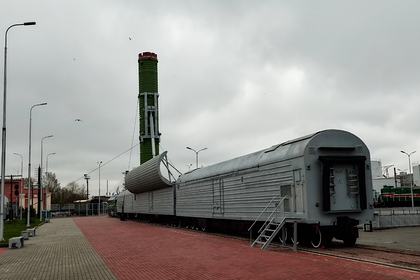
Russia could return nuclear ICBM trains to its military in response to NATO's deployment of additional missiles in Europe. The return of weapons, which could become a “nightmare for the United States,” predicted military expert Alexei Leonkov in an interview with Moskovsky Komsomolets.
According to him, the new Russian military railway missile system (BZHRK) could become an effective means of deterring the strengthening of NATO countries on the territory of European states. Leonkov recalled that similar complexes equipped with RT-23UTTKh missiles were developed in the USSR by 1987. In 1991, three BZHRK divisions were deployed in the country: in Kostroma, Perm and Krasnoyarsk. Moreover, nuclear trains traveled along the same paths as passenger or freight trains, and were well camouflaged, which made it almost impossible to detect and destroy them by enemy forces.
In 1993, within the framework of a nuclear disarmament treaty with the United States, part of the BZHRK was removed from the armament of the Russian army, and some began to be sent for “cutting” – the last train was transferred for this purpose in 2005. However, in 2009, Russia began to think about the need to create a new nuclear train.
In 2012, development work began, and in 2016 the new BZHRK passed the first tests. It is known that the successor to the Soviet nuclear train was named Barguzin. It was equipped with lighter RS-24 missiles with a range of up to 11 thousand kilometers, due to which it was lighter and had less destructive effect on railway tracks. In the future, the project was frozen, but now, according to Leonkov, it can be revived.
At the same time, another expert, former head of the military security department of the apparatus of the Russian Security Council, former chief of the General Staff of the Strategic Missile Forces (Strategic Missile Forces), Colonel-General Viktor Yesin, was skeptical about this idea. In his opinion, the reanimation of the Barguzin could provoke a new round of the arms race with the United States. “As soon as we start deploying the Barguzin, they will immediately start deploying an additional number of their intercontinental missiles. The arms race will begin. Do we need this? ” – Yesin said.
He also stressed that the existing state armaments program until 2027 does not provide for financing the BZHRK project. At the same time, the expert noted that, if necessary, Russia will be able to respond to threats arising from NATO countries with the help of other means.
In September last year, the Military Industrial Courier newspaper came up with the idea of putting the Barguzin into service with the Russian army. The publication noted that this would be one of the effective responses to the US initiative to replace the American intercontinental ballistic missiles (ICBMs) LGM-30G Minuteman III with more modern means of delivering nuclear warheads.

